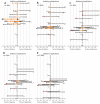Assessment of algorithms for high throughput detection of genomic copy number variation in oligonucleotide microarray data
- PMID: 17910767
- PMCID: PMC2148068
- DOI: 10.1186/1471-2105-8-368
Assessment of algorithms for high throughput detection of genomic copy number variation in oligonucleotide microarray data
Abstract
Background: Genomic deletions and duplications are important in the pathogenesis of diseases, such as cancer and mental retardation, and have recently been shown to occur frequently in unaffected individuals as polymorphisms. Affymetrix GeneChip whole genome sampling analysis (WGSA) combined with 100 K single nucleotide polymorphism (SNP) genotyping arrays is one of several microarray-based approaches that are now being used to detect such structural genomic changes. The popularity of this technology and its associated open source data format have resulted in the development of an increasing number of software packages for the analysis of copy number changes using these SNP arrays.
Results: We evaluated four publicly available software packages for high throughput copy number analysis using synthetic and empirical 100 K SNP array data sets, the latter obtained from 107 mental retardation (MR) patients and their unaffected parents and siblings. We evaluated the software with regards to overall suitability for high-throughput 100 K SNP array data analysis, as well as effectiveness of normalization, scaling with various reference sets and feature extraction, as well as true and false positive rates of genomic copy number variant (CNV) detection.
Conclusion: We observed considerable variation among the numbers and types of candidate CNVs detected by different analysis approaches, and found that multiple programs were needed to find all real aberrations in our test set. The frequency of false positive deletions was substantial, but could be greatly reduced by using the SNP genotype information to confirm loss of heterozygosity.
Figures



References
Publication types
MeSH terms
LinkOut - more resources
Full Text Sources
Other Literature Sources

